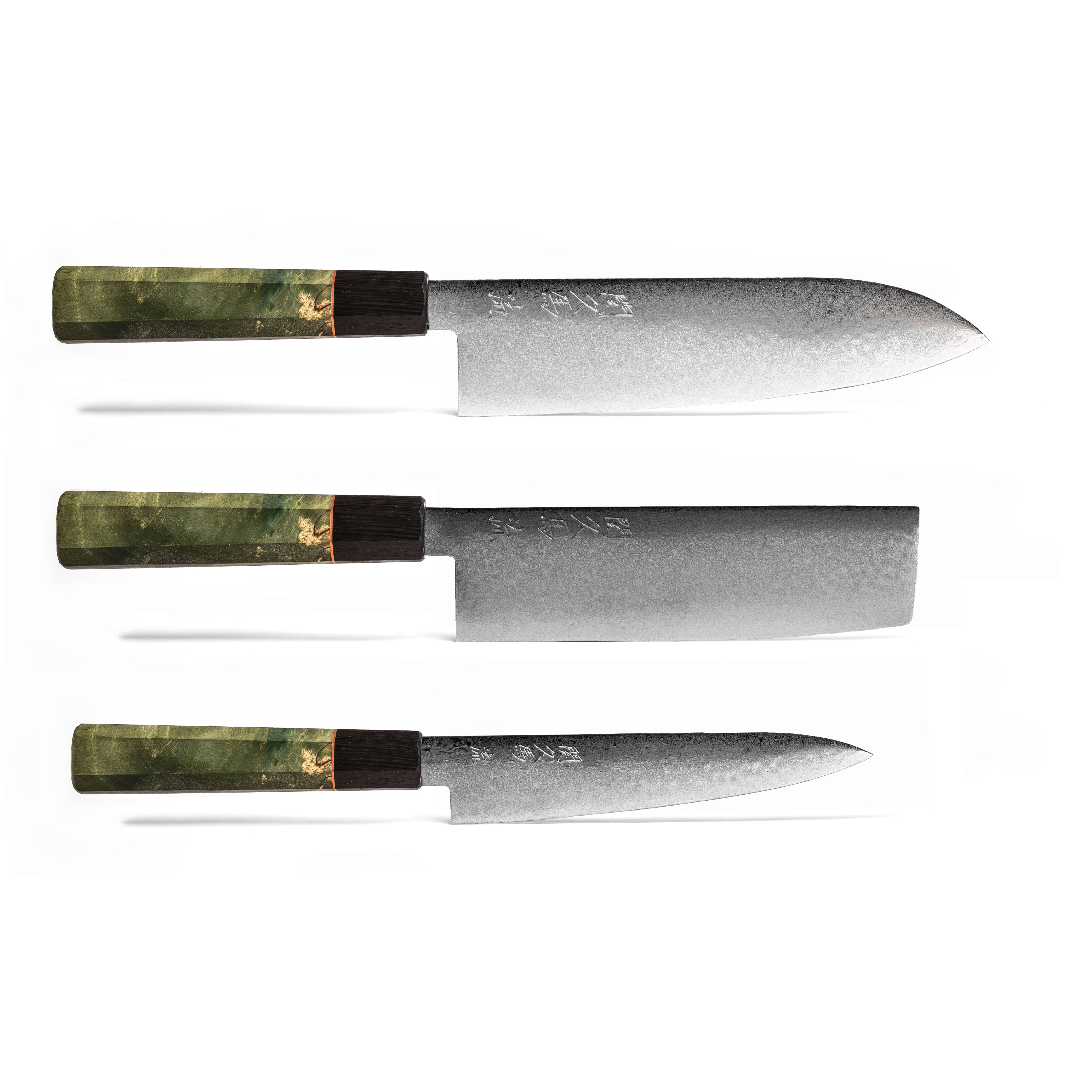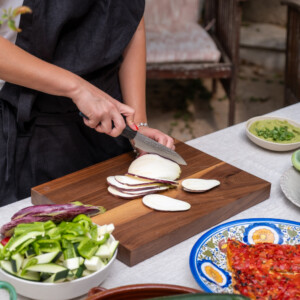If you are investing in the kitchen equipment – such as finer knives, then it’s wise to be looking after them by investing in a good chopping board. The cutting board is perhaps the most essential (after knives) tool in your kitchen for meal prep. Picking a chopping board is actually easy once you learn the properties of the materials. You will quickly realise then that the choice is obvious – you should invest in wooden end grain boards.
First, you need to understand that the edge on your knife is extremely thin and prone to damage if it pressed up against anything too hard. That’s why you should not be using Gyuto (Chef’s), Petty (Utility), Santoku and Nakiri (Veggie) knives if you plan on chopping bones (however small they may be). For that invest in a Deba knife.
When choosing a chopping board you want one, that has some give in it that the blade can press into easily.
The general rule is that you should avoid glass, marble, bamboo and steel as these are just too hard. Yes, all those bamboo boards available on marketplaces for peanuts are not the best idea. End grain wood boards made of high-end wood such as hinoki (Japanese cypress) or Aomori hiba (also called The Tree of Life), are the most suitable for preserving the longevity of your expensive kitchen knives.
To help you make a wise choice, let’s analyse the properties of the most common materials:
Wood

There are a number of different types of wooden boards. Assuming that you’ve got your student years and Ikea affair way behind you, you should leave the boards you got back then right where they belong – in the trash. Don’t look back and don’t try to get yourself into thinking that buying cheap cutting boards and changing them often will give you the same benefits as one, more premium board. Just because it’s wood does not make it good.
Self-healing wood
One of the best boards of all the available wooden ones are end-grain boards. Made from hardwoods including cypress, cherry, maple, cedar, walnut and teak and traditionally used in the manufacture of butchers’ blocks, end grain boards are glued pieces of wood with the grain perpendicular to the surface of the board. This allows the wood fibres to absorb the impact of the knife blade, by allowing it to go between the wood fibres. As a result, this prevents the edge of the blade chipping, rolling or denting and therefore preserving the sharpness of the blade
Any cuts to the board soon “heal” up when wiped down with a damp cloth, the grain swells a little to “repair” itself. Of course, the work involved in making them this way and the quality of the wood means they are more expensive than widely available boards for under 20 quid, but once you buy one, it will last you years. (We find it a good return on investment).
The easiest tip to guess if the board is an end grain or not is the thickness of the board. For such board, it’s usually over 4 inches high as this enables it to be resurfaced many times and last for a lifetime (if you look after it). The thickness also provides stability and a sturdy, durable surface.
Edge-grain
Apart from End Grain boards, there are Edge Grain ones, which are manufactured with pieces of hardwood glued with the wood fibres parallel to the surface of the board. These boards are much easier to make and are therefore cheaper. They do not share the same qualities with regards to knife care, as the end grain as you are cutting across the grain.
Frequency of refinishing depends on the thickness of the board. They look the part but are not as good to the knife as end grain. Good quality end and edge grain boards are manufactured with food grade glue and finished with non-toxic oils or in case of Aomori hiba wood which has anti-bacterial properties – left raw.
You can re-oil your board once in a while. We find that beeswax is a natural and perfect way to treat your board. Olive and vegetable oils are not suitable as they turn rancid, tainting food.
The miracle of wood

Some food hygienists do not recommend the use of wood boards as it is traditionally thought that the porous nature of wood harbours bacteria which can potentially contaminate food. They instead recommend plastic boards for all food preparation.
However, many refute this claim. And once you consider the woods with anti-bacterial properties such as hinoki or Aomori hiba, it is believed that the fibres in the wood, particularly in end grain, self heal therefore reducing the gouges in the wood for bacteria to enter. Such wood has antimicrobial properties and enzymes that make for an inhospitable environment for bacteria to grow. For those who want to read about the research carried out by Cliver and Kaspari in 1994, “The antimicrobial properties of wood”, published in the Journal of Food Protection and supported by the World Health Organisation. Plastic and wood boards were inoculated with e.coli (including 0157), salmonella and listeria.
What’s interesting, wood was found to have 98-99% fewer bacteria following this than plastic. Phew! Aside from the knife protecting and hygiene properties of wood boards, they really can be a beautiful addition to kitchen interiors, especially thick, end grain woods.
- Rated 5.00 out of 5$111
Plastic

Having said all the nasty things about plastic, we must highlight its advantages. Plastic (polyethene) boards do have a number of benefits in that they are lightweight, so food is easily transferable to the cooking pot or bin with ease. They are also highly recommended by food hygienists, especially in commercial kitchens to reduce the risk of food contamination linked with wood boards. Plastic can withstand exposure to water so they are perfect for cleaning in a dishwasher.
Plastic can also tolerate harsh chemical cleaning by bleach and will not retain such chemicals within to later contaminate food. However, the softer nature of plastic is susceptible to scoring by knives. Apart from the unaesthetic look, cuts and grooves can harbour bacteria, even following thorough cleaning. Knives are also prone to chipping and blunting, as the plastic does not absorb the impact of the blade as seen with end grain wood boards. Plastic boards can be unstable and are therefore prone to slipping increasing the risk of hand injuries. Let’s be honest, after a few weeks they don’t look neat anymore and need to be replaced more frequently than wooden ones.
Bamboo

Bamboo boards are sold as the ‘eco-friendly‘ chopping board due to bamboo being fast growing, biodegradable, it’s cultivation being free of pesticides and not having a negative impact on pandas. Due to its fast-growing abilities bamboo is cheap compared to the end grain premium hardwood. However, bamboo is really hard and there is no grain for the knife to go into. As a result, the knives will quickly go blunt.
Mass manufacturers claim that bamboo is tougher than maple and oak, it is lightweight (lending itself to easy transfer to sink for cleaning), strong and durable and that knives won’t suffer friction blunting, as can happen with wood or plastic. The strength of the bamboo means that heavy-duty cutting and chopping can be done without shattering or splintering the surface of the board.
It is also claimed that a bamboo is a hygienic option as due to the hardness of the wood, it sustains very few grooves from knives which may harbour bacteria. What makes bamboo so attractive is also its downside. Some knife manufacturers do not recommend bamboo boards for their knives due to the hardness of the wood and its potential to damage the blade as it does not absorb the impact of the knife unlike end grain wood boards. Bamboo does have a tendency to absorb stains and will warp if immersed in water. And if that’s not enough, Some bamboo cutting boards are glued together with adhesives that have formaldehyde in them — which could eventually leak into and contaminate food. When buying a bamboo cutting board, make sure that it has a non-toxic label on it in order to avoid this.
Everything Else

If none of the above board materials doesn’t appeal to you, there are other alternatives such as rubber boards. They are increasing in popularity, having found their glory in commercial kitchens. And are believed to have the same knife protection as wood boards and also similar self-healing abilities. Therefore, an inability to harbour significant amounts of bacteria or moisture. They can withstand chemical disinfectants and in commercial kitchens such quantities are substantial. Rubber boards are generally made to be thick, solid rubber heavy pads that don’t slip.
As with everything in life, you can find the cheap and very expensive versions. We are not a huge fan of plastic and rubber, hence we can’t really say if they are worth the hustle. So as with glass, steel, granite and marble boards – although they look nice and often are used for photo shoots, they are not the best for real life use. Why? Simply because all of them are hard surfaces and can completely ruin a knife. Marble will also slowly dissolve if exposed to acidic foods such as tomatoes, citrus and vinegar. Blades can easily chip on these surfaces and the longevity of the knife will be drastically reduced. Not to mention that materials such as marble or glass can easily slip when wet. Get one if you like photographing your food, but keep it for this purpose only – as a background.




































